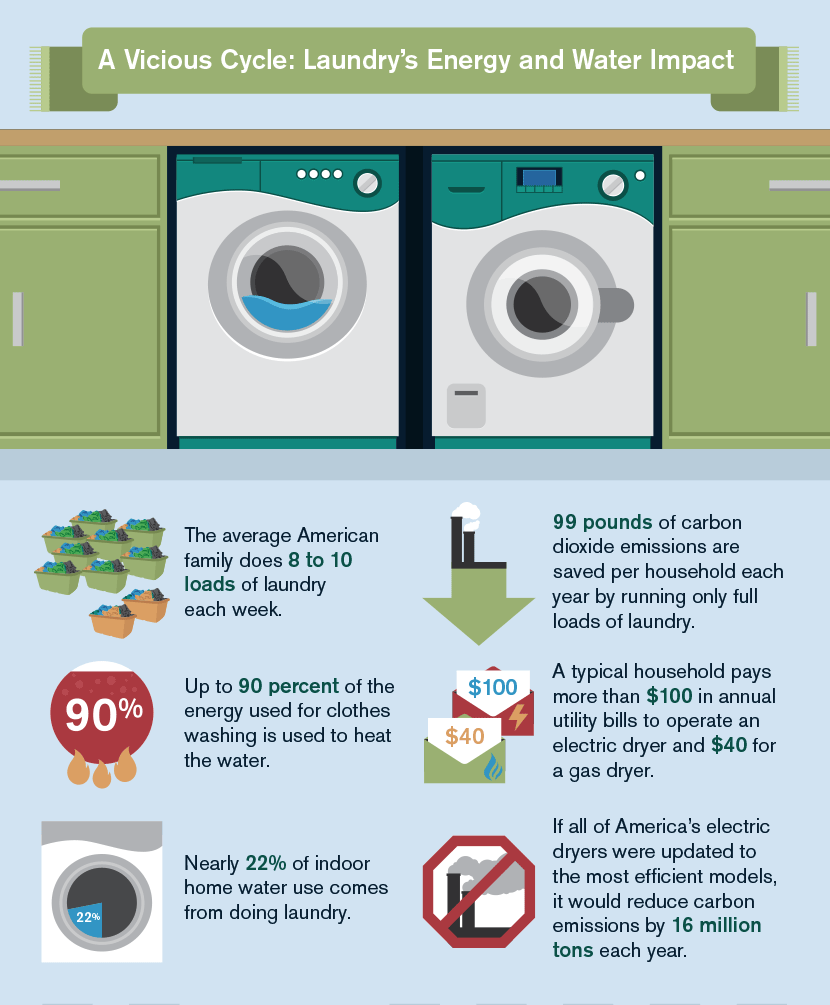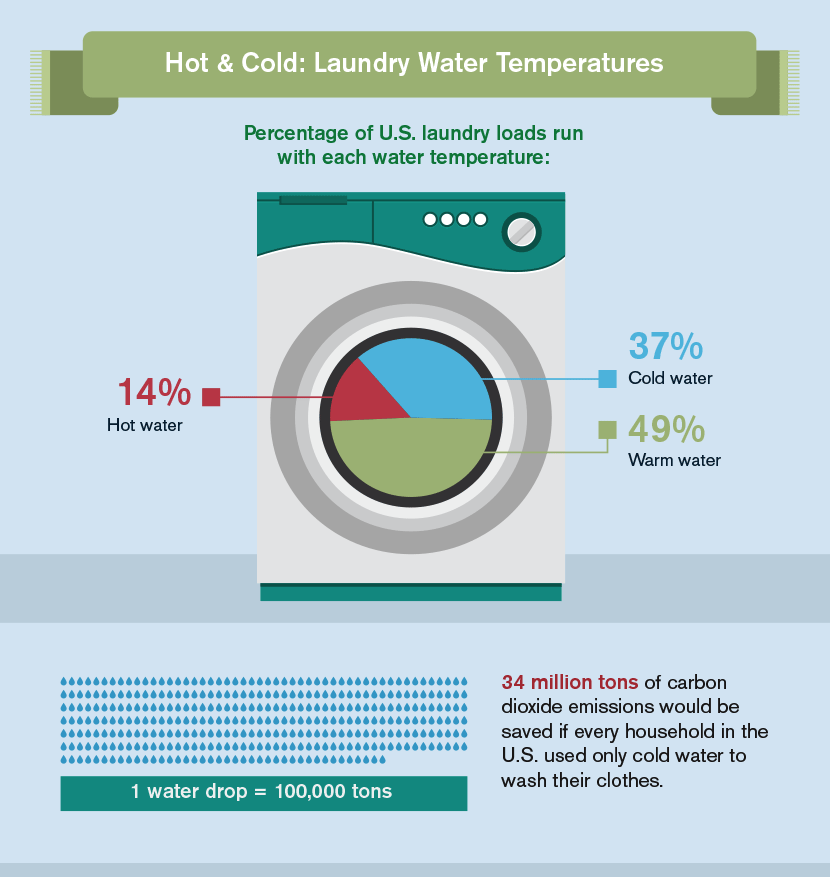How and Why You Should Green Your Laundry Routine
Laundry is one of those chores people like to get done quickly. But however mundane the task,
it’s worth reassessing your cleaning routine. A few simple changes can improve your health and make a positive dent in your eco-footprint.
Why should you care about greening your laundry? For starters, many of the chemicals found in common laundry products are hazardous
to both humans and the environment (and many more have not been
thoroughly tested for safety).http://www.ewg.org/enviroblog/2013/03/five-noteworthy-findings-ewg-s-guide-healthy-cleaning Any product that clothing is exposed to
– including detergents, fabric softeners, and dryer sheets – coats the fabrics in residues that inevitably come in contact with skin.http://www.motherearthliving.com/health-and-wellness/toxic-laundry-detergent-ingredients-zmez12mazmel.aspx
Effects of direct or airborne exposure to these
pollutants can include headaches, dizziness, respiratory issues, and even cancer.http://www.epa.gov/iaq/ia-intro.html
Chemicals from these products can also contaminate soil and groundwater after entering the sewer system, and are toxic to marine life.
Scented laundry products are of particular concern. One study
found that scented products emit more than 100 volatile organic compounds
(VOCs), including some that are recognized as toxic or hazardous.http://www.ncbi.nlm.nih.gov/pmc/articles/PMC3018511/
Disappointingly, products labeled “green,” “natural,” or “organic”
have been found to emit just as many dangerous chemicals as standard consumer goods. Many of these chemicals are considered carcinogenic
and contribute to air pollution. "The Environmental Protection Agency (EPA) warns that indoor pollution from cleaning products is likely
to be hazardous to health, but there are no federally enforceable standards for their use in the home."http://www.epa.gov/iaq/ia-intro.html
Chemicals aren’t the only concern when it comes to laundry’s effect on the environment.
Simply running washers and dryers uses up a tremendous amount of electricity and water.
Tally up all the loads you do in a week (or a month, or a year): All that laundry adds up to a major energy drain.http://momsneedtoknow.com/green-laundry-routine/#6q0Z9kx2RrW0MEaA.99
Convinced it’s time to make some changes in the laundry room? Reduce your impact on the environment (and improve your health) by making any or all of the following changes to your laundry routine.

So Fresh and So Green: Eco-Friendly Laundry Tips

Do Laundry Less Often
Unless they’re stained or stinky, most articles of clothing can be worn several times before washing
(but stick to one wear for most undergarments).http://www.treehugger.com/htgg/how-to-go-green-laundry.html
Filling up the laundry basket more slowly saves water and energy.
When it’s time to run a load, be sure to fill up the machine for maximum efficiency. (Don’t go beyond the fill line, though, which can reduce cleaning performance.)
Choose Greener Machines
Don’t toss a machine until it’s fully dysfunctional:
Disposing of appliances before they’re used up just adds to landfill waste. But when it is time to replace a broken machine,
choose an eco-friendly version.http://www.motherearthliving.com/homemade-cleaners/how-to-green-your-laundry-routine.aspx
When choosing a washer, look for a low water factor, which determines the number of gallons used per cycle per cubic foot. The lower the water factor,
the more eco-friendly the machine. Also, choose a front-loading machine, which can use half as much water as top-loading machines.
Wash in Cold Water
Up to 90 percent of the energy used for clothes washing is gobbled up when heating the water,
which is costly for both your wallet and the environment.http://www.treehugger.com/htgg/how-to-go-green-laundry.html
Virtually all clothes can be washed in cold water – even when the label calls for warm.

Line Dry
Hang clothes to dry on an outdoor line or a clothes rack indoors to save energy. If using a clothesline,
practice smart strategies for line drying clothes: Keep the line clean (so it doesn’t leave marks on clothes),
choose clothespins that won’t leave imprints on delicate clothing, and keep the line taut so clothes don’t drag on the ground.
Dry Right
If you choose to use the dryer, get the most energy bang for your buck by
drying multiple loads back-to-back.http://money.usnews.com/money/blogs/my-money/2011/02/23/how-to-green-your-laundry-room
The dryer will already be warmed up, which requires less energy than going from cool to hot for each load.
Clean the lint filter before every load, which helps the dryer work more efficiently. And take advantage of the moisture sensor,
if your dryer has one: the sensor shuts off the machine when the clothes are dry, which saves energy on useless tumbling.
Skip the Iron
Here’s one more excuse to skip ironing in the morning: It uses up electricity and is tough on fabrics. If you’re worried about looking rumpled,
hang up clothes the minute you take them out of the washer:
The weight of the water will help pull
out most wrinkles.http://www.treehugger.com/htgg/how-to-go-green-laundry.html
Once the clothes are dry, fold them where you want the creases to be.
Ditch the Dry Cleaner
Most dry cleaners use a nasty chemical
called perchloroethylene (PERC),
which is harmful to both humans and the environment.http://www.nrdc.org/living/stuff/dry-cleaning.asp
Exposure to PERC can negatively affect the central nervous system, kidney, liver, and reproductive system, and cause mood or behavioral changes.
The chemical is also a source of toxic air pollution and hazardous waste, and has been shown to contaminate soil and groundwater near the businesses
where it’s used. PERC can even affect indoor air quality for people who regularly bring home dry-cleaned clothes.
Purchase clothes that can be washed either in a conventional washer or by hand. Many delicates, including cashmere and lamb’s wool, can be safely washed by hand.
Avoid Bleach
While some experts consider most household applications of bleach to be safe, the popular
disinfectant can provoke respiratory issues (particularly in people with asthma)
and create toxic chlorine gas if mixed with acidic products such as vinegar or ammonia.http://www.mnn.com/your-home/at-home/stories/is-it-safe-to-clean-with-bleach
Bleach byproducts have also been shown to be toxic to birds and fish. For a
nontoxic alternative, add some lemon juice to the
washing machine’s rinse cycle. It’s a natural disinfectant that kills germs without hurting anything.http://www.health.com/health/article/0,,20411040,00.html
Remove Stains With Bar Soap
Remove tough spots before running clothes through the washer by using a nontoxic bar of soap as a stain stick.
Wet a corner of the bar, rub it on the stain until it’s
completely covered, toss the garment into the washer, and proceed as usual.
Make Your Own Dryer Balls and Sheets
Dryer balls decrease drying time by
separating clothes and letting hot air circulate more easily; this cuts down on the energy used to power the dryer.
The more dryer balls you add to a load, the more effective they are.http://www.diynatural.com/how-to-make-wool-dryer-balls/
Wool dryer balls also eliminate the harmful chemicals and perfumes found in most conventional
fabric softeners and dryer sheets. Plus, they’re made from a renewable resource. The wool balls reduce static and soften clothes the natural way.
Follow these handy guides to make your own wool dryer balls or
DIY dryer sheets.http://www.diynatural.com/homemade-fabric-softener-dryer-sheets/
Make Your Own Laundry Detergent
Even so-called “green” detergents can contain potentially harmful chemicals, because there are no regulations
requiring them to disclose their ingredients.http://grist.org/article/its-a-wash/
You can ensure eco-friendly washing by making your own detergent at home. This simple recipe calls for glycerin soap, washing soda, baking soda, citric acid, and
coarse salt.http://myhealthygreenfamily.com/blog/wordpress/homemade-borax-free-laundry-detergent/
Not up for DIY? Avoid these ingredients when shopping for store-bought
detergents.http://www.motherearthliving.com/laundry-chemicals-to-avoid-zmez12mazsie.aspx
Or try soap nuts, which release saponin, a compound that helps water remove dirt and stains from clothing when agitated in the washing machine.http://www.care2.com/greenliving/diy-clean-laundry-alternatives.html/3
Compost your used soap nuts for extra green points.
Make Your Own Fabric Softener
Skip the liquid softener and keep clothes soft and cuddly without added toxins. You can make a
large batch of DIY fabric softener by adding 20 to 30 drops of your favorite essential
oil to one gallon of white vinegar.http://www.care2.com/greenliving/diy-clean-laundry-alternatives.html/4 To use, shake the mixture and add approximately 1/3 cup
of the mixture during the rinse cycle.
Scent Laundry the Non-Toxic Way
Add a fresh scent to laundry without exposing your house or our waterways to toxic perfumes and fragrances.
Stuff a sachet with dried herbs and
flowers such as lavender or peppermint and toss it in the dryer with your clothes.http://www.care2.com/greenliving/diy-clean-laundry-alternatives.html?page=3
Whether you adopt all the tips on this list or pick and choose your own eco-friendly laundry regimen, you’ll be doing a service for the health of your household and the environment for years to come.
Embed the article on your site

